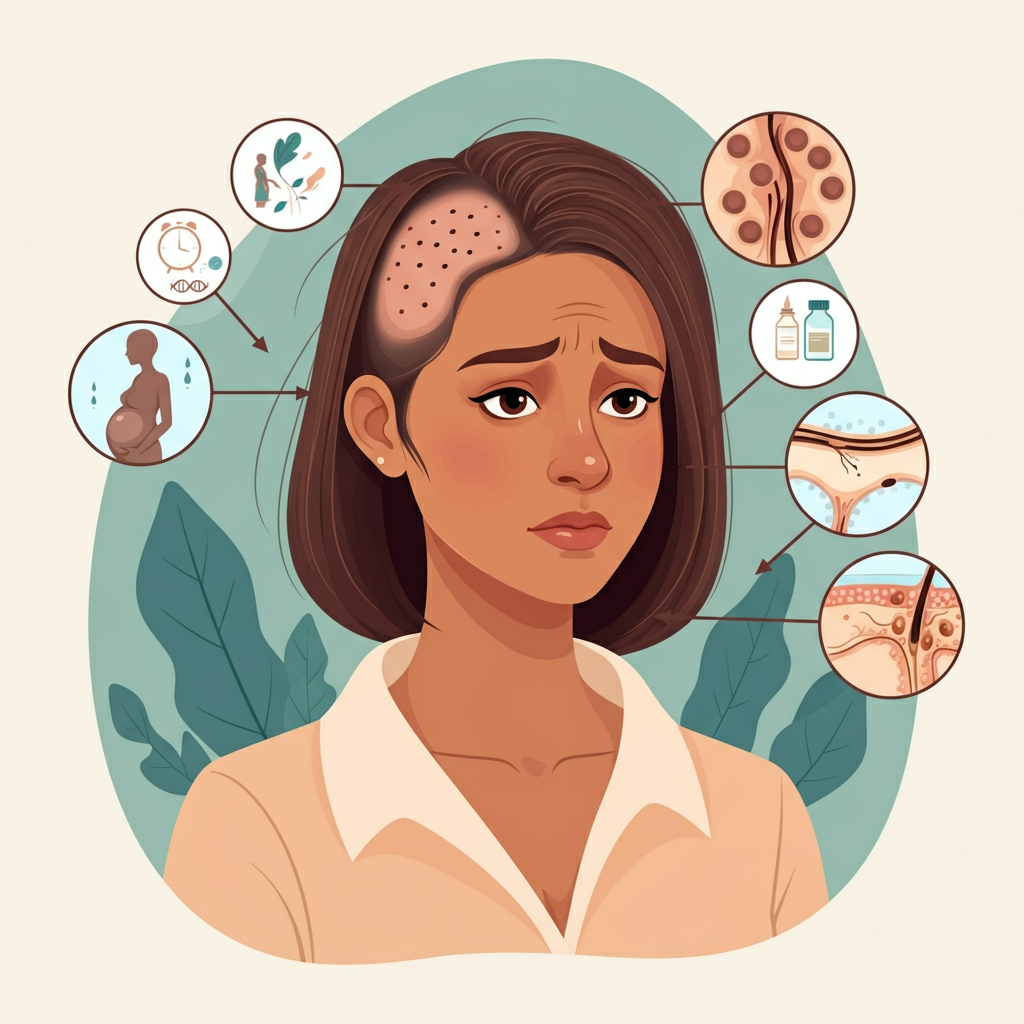
Hair is often considered a woman’s crowning glory, but what happens when strands thin, or worse, fall out unexpectedly? Hair loss is a common concern for women of all ages, affecting self-esteem, mental health, and daily routines. While shedding some hair each day is normal, excessive hair loss can signify deeper underlying issues.
This blog will explore the common causes of hair loss in women, ranging from hormonal changes to nutritional deficiencies. It will provide practical insights to help you act. Whether you’re experiencing thinning, patchiness, or overall shedding, understanding these causes is the first step towards diagnosis and treatment.
Why Understanding Hair Loss Is Crucial
Hair loss in women is more than a cosmetic issue—it can indicate health concerns, stress, or nutritional imbalances. While some causes are temporary and reversible, others may require timely intervention to prevent further hair loss. The earlier you identify the cause, the better your chances of managing and even reversing the condition.
Common Causes of Hair Loss in Women
1. Genetics and Hereditary Factors
For many women, genetics contributes to hair loss. Female-pattern baldness, also known as androgenetic alopecia, affects up to 30 million women in the United States alone. This hereditary condition causes thinning along the crown and widening of the part over time.
Genetic hair loss typically begins after puberty and is more evident after age 40 or during menopause. If your family has a history of hair thinning, chances are high that it may affect you as well.
What You Can Do:
-
Consider treatment options such as minoxidil, a topical solution FDA-approved for female-pattern baldness.
-
Early intervention includes speaking with a dermatologist or trichologist for tailored advice.
2. Hormonal Changes
Hormonal fluctuations are a common culprit when it comes to hair loss in women.
Key Conditions Include:
-
Pregnancy and Postpartum Hair Loss: Many women experience significant shedding postpartum due to hormonal changes. This is often temporary and resolves within months.
-
Menopause: A decline in estrogen and progesterone levels during menopause often leads to thinner, weaker hair. Androgens, or male hormones, can further exacerbate hair loss.
-
Polycystic Ovary Syndrome (PCOS): This condition disrupts hormone levels, often leading to thinning hair on the scalp and excessive growth in other areas.
-
Hormonal Contraceptives: Starting or stopping birth control pills can also trigger temporary hair thinning.
What You Can Do:
-
Look into hormone-balancing treatments if needed.
-
Follow up with your doctor to explore hormone therapy options.
-
Focus on nourishing your hair with proper care and essential nutrients.
3. Thyroid Imbalances
An underactive (hypothyroidism) or overactive (hyperthyroidism) thyroid can disrupt the delicate balance of hormones critical for hair growth. Hair may thin out all over the scalp and become brittle or weak.
Symptoms to Watch For:
-
Weight changes
-
Fatigue
-
Dry skin and brittle nails
What You Can Do:
-
Perform thyroid function tests with your healthcare provider.
-
Medications or treatments to balance thyroid levels can restore healthier hair growth.
4. Nutritional Deficiencies
Your diet plays a significant role in hair health. Deficiencies in key nutrients like iron, vitamin D, biotin, and zinc can cause hair thinning.
Key Nutritional Triggers:
-
Iron Deficiency: Often linked to anemia, which affects hair follicle regeneration.
-
Vitamin D Deficiency: Plays a vital role in the hair follicle cycle.
-
Zinc & Biotin Deficiencies: Both nutrients are critical for strengthening hair and preventing breakage.
What You Can Do:
-
Incorporate iron-rich foods such as spinach, beans, and lean meats into your diet.
-
Consider supplements for vitamins and minerals, but consult a healthcare provider first.
5. Stress and Emotional Factors
Stress can wreak havoc on nearly every aspect of your body, including your hair. Telogen effluvium, a condition where stress sends your hair follicles into a resting phase, can cause noticeable shedding.
Triggers Include:
-
Stress caused by a personal issue, like job loss or divorce.
-
Physical stress, including surgery, illness, or childbirth.
What You Can Do:
-
Engage in stress-relieving activities like yoga, meditation, or therapy.
-
Be patient; stress-related hair loss typically reverses itself once the stressor is removed.
6. Medical Conditions and Autoimmune Diseases
Autoimmune conditions like alopecia areata cause the immune system to attack hair follicles, resulting in patchy bald spots. Other chronic diseases, like lupus and diabetes, can also contribute to thinning hair.
What You Can Do:
-
Seek medical advice promptly for autoimmune-related or chronic conditions.
-
Treatments like corticosteroids or immunosuppressive medications may be recommended.
7. Hair Care Practices and Styling Habits
Excessive heat styling, chemical treatments, and tight hairstyles such as ponytails or braids can lead to traction alopecia. These habits weaken hair strands and stress follicles.
What You Can Do:
-
Avoid overusing chemical or chemical-based styling tools.
-
Keep hairstyles loose to reduce follicle tension.
Prevention and Available Treatments
The good news is that hair loss can often be managed with the right approach.
1. Treatment Options
-
Topical Solutions: Minoxidil (Rogaine) is commonly recommended to promote hair regrowth.
-
Nutritional Supplements: Iron, biotin, and vitamin D supplements support healthy hair growth.
-
Platelet-Rich Plasma Therapy (PRP): A cutting-edge option where patient’s own plasma is injected to stimulate hair growth.
-
Hair Transplant Surgery: A long-term solution for advanced cases of thinning or baldness.
2. Lifestyle Adjustments
-
Maintain a balanced diet rich in nutrients.
-
Practice gentle hair care techniques.
-
Reduce stress with mindfulness exercises or professional counseling.
3. Early Diagnosis Matters
Spotting the first signs of hair thinning and seeking help early can make all the difference. Dermatologists and hair specialists can identify causes and offer personalized treatments.
Time to Control Your Hair Health
Hair loss, while distressing, doesn’t have to be permanent. By understanding the causes behind thinning and shedding, you can take meaningful steps toward healthier hair. If you’re experiencing hair loss, consider consulting a dermatologist or trichologist to determine the most effective course of action.
Addressing hair loss early can prevent further thinning and restore your confidence. Remember, healthy hair starts from the inside out, so invest in proper care and nourishment today.







